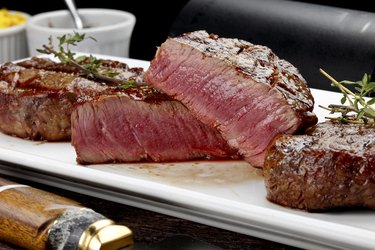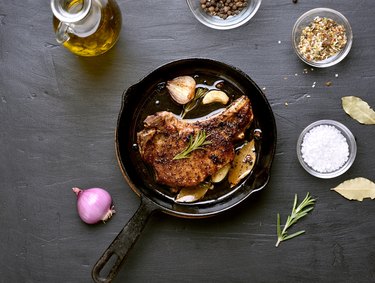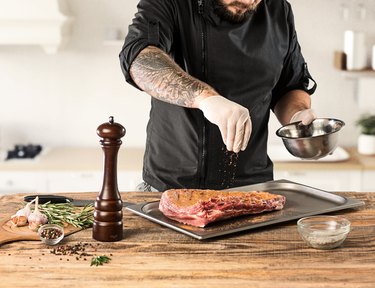
If you don't own a grill or don't want to brave the elements to cook outdoors, you can still cook a tender steak in the oven. There are two main ways to go about this task; the strategy you use depends on the cut of the steak.
Tough cuts with lots of connective tissues benefit from wet cooking strategies, such as braising or stewing. Lean, tender prime cuts can be finished at a low temperature in an oven, but you won't have to cook them long because they shouldn't be cooked beyond medium rare.
Video of the Day
Video of the Day
No matter what cut or approach you use, brown the steak first over high heat to create a flavorful crust. Here's your foolproof guide to slow cook steak in the oven.
Things You'll Need
2 to 3 pounds of steak
Salt
Pepper
Oil
Flour
Cast iron skillet
Instant-read meat thermometer
Baking rack
Baking pan
Serving dish
Casserole dish or Dutch oven
Cooking liquid or sauce of choice
Spatula
Small cup
Corn starch
Prepare Your Steaks
Step 1: Thaw and Season
Remove the steak from your refrigerator 30 minutes before you cook. Pat it dry with paper towels. Rub the steak generously with salt and pepper. The salt will help to tenderize the steak.
Step 2: Preheat and Prepare
Preheat the oven to 325 degrees Fahrenheit. Rub the steak with oil. If you're cooking a tough steak using a wet technique, dredge the steak in flour.
Read more: How to Cook Tough Beef Tender
Step 3: Sear the Steak
Preheat a skillet over high heat on the stove for several minutes. Pour a drop of water onto the skillet; if it sizzles, the skillet is hot enough. Heat one tablespoon of oil in the skillet for about 20 seconds. Sear each side of the steak for one minute, turning it with tongs.

Dry Baking Tender, Prime Steaks
Tender cuts of prime steak such as T-bone, tenderloin, porterhouse, New York strip, Kansas City strip, sirloin and rib eye have little connective tissue and collagen, so they're best cooked for short periods of time using dry methods. Overcook these tender cuts and they become tougher, as the protein strands coil under the heat.
Step 1: Transfer to Oven
Stick an instant-read meat thermometer into the side of the steak. Transfer the skillet to the middle rack of the oven. If your skillet handle isn't oven-proof, transfer the steak to a baking rack placed in a baking pan. Put the baking pan on the middle rack of the oven.
Step 2: Cook and Test Temperature
Cook the steak uncovered for eight to 10 minutes until the center of the steak reaches 130 degrees Fahrenheit for a medium rare cook, or 140 degrees Fahrenheit for a medium cook.
Step 3: Rest and Serve
Move the steak to a plate, cover it loosely with aluminum foil and let it rest for 10 minutes before serving.
Read more: How to Cook Shish Kabobs in the Oven
Wet Cooking Tough Steaks
Tough cuts of steak such as round, flank, skirt, blade, arm, 7-bone and chuck steak benefit from cooking with fluid. The longer they cook, the more the collagen breaks down and the more tender the steaks become.
Read more: How to Cook Skirt Steak in the Oven
Step 1: Cover with Liquid
Transfer the steak to a casserole dish or Dutch oven. Cover the steak with a liquid or sauce. Common cooking liquids include broth, tomato sauce, diced tomatoes, wine, beer and cream soups.
Step 2: Deglaze and Add Veggies
Deglaze the skillet, if you wish. Add two tablespoons of water or broth to the skillet and bring it to a boil over the stove, scraping the bottom of the pan to loosen charred meat and pan drippings. Add the deglazing liquid to the casserole dish or Dutch oven. Add any vegetables your recipe calls for, as well.
Step 3: Cook and Add Liquid
Cook until the meat is tender, about two to three hours. The longer you cook the steak, the more moist and tender it will become, as long as you don't let your cooking liquid run dry.
Step 4: Thicken the Sauce
If you prefer a thicker sauce, mix two tablespoons of corn starch with two tablespoons of water in a cup. Stir in the cornstarch mixture a little bit at a time while the liquid boils until the liquid reaches the thickness you wish.

Tips for Slow Cooking Steak in the Oven
With the right tricks up your sleeve, you can slow cook a tender steak in your oven every time.
1. Choose the Best Skillet
While you may be used to using nonstick pans for your cooking needs, a cast iron skillet will be a much better choice in this instance for several reasons.
A nonstick pan is easy to clean, but it doesn't handle high heat well. Since you'll either be pan searing and transferring the skillet to the oven, or vice versa, a cast iron skillet will handle both of these tasks best and eliminate the need to use multiple pans for your steak cooking needs.
What's more is that a cast iron skillet is perfectly flat, allowing the entire steak to come in contact with the surface evenly for the perfect sear and cook.
2. Bring to Room Temperature
If you take your steak straight from the fridge to the pan, you may end up with a less than ideal meal at the end of your cook. Give your steak 30 to 60 minutes on the counter, and the end result will be much tastier.
When the meat has heated to room temperature, once it hits the overn, it'll heat up much more quickly and evenly, both internally and externally. If you take it straight from the fridge to the hot oven, the outside will cook much faster than the inside and you'll likely end up with an overcooked exterior and an undercooked interior.
3. Season Generously
No matter which recipe you use, seasoning is important, even if it's just adding salt and pepper. You may choose to season prior to cooking, or even after you've seared your steak.
Don't be shy with the seasonings either! James Beard Award winning Chef Ming Tsai says, "The only thing worse than using too much salt is not using enough." Consider a solid coat of seasoning on the outside of the steak, whether it be salt and pepper or any combination of spice rubs. If you choose to sear, you'll end up with a tasty crust as a result.
Whatever you do, make sure you add your chosen flavors prior to letting your steak rest to make certain the seasonings have enough time to work into the meat.
4. Pay Attention to Temperature
If you have a specific cut you're looking for, from rare to medium-well, make sure you have a reliable meat thermometer handy to ensure your steak is just the way you like it. Take these temperatures into account and check your steak every few minutes to make sure it doesn't overcook:
- Rare: 125 degrees Fahrenheit
- Medium-rare: 130 to 135 degrees Fahrenheit
- Medium: 140 to 145 degrees Fahrenheit
- Medium-well: 150 degrees Fahrenheit
5. Don't Skip the Sear
Sure, you can put your steak straight into the oven and cook it to your liking, but you'll be missing out on added flavor and char, as well as texture. You can either sear before putting the steak in the oven or, for thicker cuts of steak that might start to dry out on the edges, consider finishing it off in the pan post-oven.
If you're doing a pre-oven sear, make sure your skillet is extremely hot before the steak hits the pan for an optimal outcome.
6. Let It Rest
Prior to serving, make sure you let your steak rest. If you take it out of the oven or pan post-sear and cut immediately, you'll end up losing a lot of the steak's juices and flavors before it gets to the plate and the end result will be a tough steak. Put it aside and give it five to 10 minutes before slicing.
- Beef It’s What’s for Dinner: Know Your Cuts and How to Cook Them
- Wet Cooking Methods | Cooks Illustrated
- How To Cook A Perfect Steak Indoors | Chatelaine
- Home Cooking Recipes Lifestyle Housekeeping Entertaining home-cooking cooking-pan-correct Nonstick, Cast Iron, Stainless Steel: Which Cooking Pan Is Right for the Job?
- How To Cook A Damn Good Steak In The Oven | delish
- The 4 Best Methods to Cook a Steak Indoors | The Spruce Eats
- 5 Best Tips for Cooking Steak | The Pioneer Woman
- 5 Expert Steak Tips: How You Can Cook A Perfect Steak Every Time | Forbes